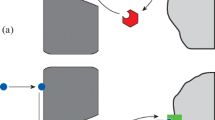Summary
Concerning its fine structure the pseudoculus of Eosentomon is quite similar to that of Acerentomide Protura. There are two sensory cells innervating the organ. From each of them one dendritic process derives, surrounded by one enveloping cell. The processes of these four cells enter the distal cavity of the pseudoculus through a pore in the endocuticular layer. The cuticular layer of the cap seems to consist of epicuticle only. It is furrowed by long clefts connecting the distal cavity of the organ with the outside. Poretubules insert at the base of the clefts and may have contact with the cell membranes of both enveloping cells and dendritic processes. According to its structure the pseudoculus may function as chemo-, hygro- and/or thermoreceptor.
Zusammenfassung
In der Feinstruktur unterscheidet sich der Pseudoculus vonEosentomon nicht wesentlich von dem der Acerentomiden. Durch einen Endokutikulaporus treten die dendritischen Fortsätze zweier Sinneszellen, jeweils umgeben von einer Hüllzelle, in den Außenraum des Pseudoculus ein. Der Außenraum wird nach distal von einer äußeren Kutikulaschicht — vermutlich Epikutikula — abgeschlossen. Sie vermittelt durch regelmäßig angeordnete lange Spalten die Verbindung zur Außenwelt. Am Grunde der Spalten finden sich Porentubuli, die mit den Hüllzellen oder den distalen Fortsätzen der Dendriten Kontakt haben können. Aus der Feinstruktur kann geschlossen werden, daß der Pseudoculus als Chemo-, Hygro- und/oder Thermorezeptor fungiert.
Similar content being viewed by others
Literatur
Altner, H., Ernst, K.-D., Karuhize, G.: Untersuchungen am Postantennalorgan der Collembolen. I. Die Feinstruktur der postantennalen Sinnesborste vonSminthurus fuscus L. Z. Zellforsch.111, 263–285 (1970).
Altner, H., Thies, G.: Reizleitende Strukturen und Ablauf der Häutung an Sensillen einer euedaphischen Collembolenart. Z. Zellforsch.129, 196–216 (1972).
Bedini, C., Tongiorgi, P.: The fine structure of the pseudoculus of Acerentomide Protura (Insecta Apterygota). Monit. zool. ital. (N. S.)5, 25–38 (1971).
Blaney, W. M., Chapman, R. F., Cook, A. G.: The structure of the terminal sensilla on the maxillary palps ofLocusta migratoria (L.), and changes associated with moulting. Z. Zellforsch.121, 48–68 (1971).
Boeckh, J., Kaißling, K. E., Schneider, D.: Insect Olfactory Receptors. Cold Spr. Harb. Symp. quant. Biol.30, 263–280 (1965).
Chu, I-Wu; Axtell, R. C.: Fine structure of the dorsal organ of the house fly larva,Musca domestica L. Z. Zellforsch.117, 17–34 (1971).
Ernst, K.-D.: Die Feinstruktur der Riechsensillen auf der Antenne des AaskäfersNecrophorus (Coleoptera). Z. Zellforsch.94, 72–102 (1969).
Ernst, K.-D.: Die Ontogenie der basiconischen Riechsensillen auf der Antenne vonNecrophorus (Coleoptera). Z. Zellforsch.129, 217–236 (1972).
François, J.: Anatomie et morphologie céphalique des Protoures. Mém. Mus. Nat. Hist. Nat. Sér. A49, 1–144 (1969).
Haupt, J.: Beitrag zur Kenntnis der Sinnesorgane von Symphylen (Myriapoda). II. Feinstruktur des Tömösváryschen Organs vonScutigerella immaculata Newport. Z. Zellforsch.122, 172–189 (1971).
Karuhize, G. R.: The structure of the postantennal organ inOnychiurus sp. and its connections to the central nervous system. Z. Zellforsch.118, 263–282 (1971).
Lacher, V.: Elektrophysiologische Untersuchungen an einzelnen Rezeptoren für Geruch, Kohlendioxyd, Luftfeuchtigkeit und Temperatur auf den Antennen der Arbeitsbiene und der Drohne (Apis mellifica L.). Z. vergl. Physiol.48, 587–623 (1964).
Locke, M.: The structure and formation of the cuticulin layer in the epicuticle of an insect,Calpodes ethlius (Lepidoptera). J. Morph.118, 461–494 (1966).
Moulins, M.: Les sensilles de l'organe hypopharyngien deBlabera craniifer Burm. (Dictyoptera). J. Ultrastruct. Res.21, 474–513 (1968).
Noirot, Ch., Noirot-Timothée, C.: La cuticle proctodéale des Insectes. II. Formation durant la mue. Z. Zellforsch.113, 361–387 (1971).
Paclt, J.: Biologie der primär flügellosen Insekten. Jena: G. Fischer 1956.
Schmidt, K., Gnatzy, W.: Die Feinstruktur der Sinneshaare auf den Cerci vonGryllus bimaculatus Deg. (Saltatoria, Gryllidae). II. Die Häutung der Faden- und Keulenhaare. Z. Zellforsch.122, 210–226 (1971).
Scott, D. A., Zacharuk, R. Y.: Fine structure of the antennal sensory appendix in the larva ofCtenicera destructor (Brown) (Elateridae, Coleoptera). Canad. J. Zool.49, 199–210 (1971).
Slifer, E. H., Sekhon, S. S.: Fine structure of the sense organs on the antennal flagellum of a flesh fly,Sarcophaga argyrostoma R.-D. (Diptera, Sarcophagidae). J. Morph.114, 185–207 (1964).
Slifer, E. H., Sekhon, S. S., Lees, A. D.: The sense organs on the antennal flagellum of aphids (Homoptera), with special reference to the plate organs. Quart. J. micr. Sci.105, 21–29 (1964).
Steinbrecht, R. A., Müller, B.: On the stimulus conducting structures in insect olfactory receptors. Z. Zellforsch.117, 570–575 (1971).
Tuxen, S. L.: Phylogenetical trends in the Protura. Z. zool. Syst. Evolut.-Forsch.1, 277–310 (1963).
Weber, H.: Grundriß der Insektenkunde. Stuttgart: G. Fischer 1964.
Yin, Wen-Ying: Studies on Chinese Protura. II. A new family of the suborder Eosentomoidea. Acta entomol. sin14, 186–195 (1965).
Zacharuk, R. Y.: Fine structure of the peripheral terminations in the porous sensillar cone of larvae ofCtenicera destructor (Brown) (Coleoptera, Elateridae), and probable fixation artifacts. Canad. J. Zool.49, 789–799 (1971).
Author information
Authors and Affiliations
Additional information
Für technische Mitarbeit danke ich Frau G. Raabe, für die Anfertigung der Zeichnung Frau C. St. Friedemann.
Rights and permissions
About this article
Cite this article
Haupt, J. Ultrastruktur des Pseudoculus vonEosentomon (Protura, Insecta). Z.Zellforsch 135, 539–551 (1972). https://doi.org/10.1007/BF00583435
Received:
Issue Date:
DOI: https://doi.org/10.1007/BF00583435




